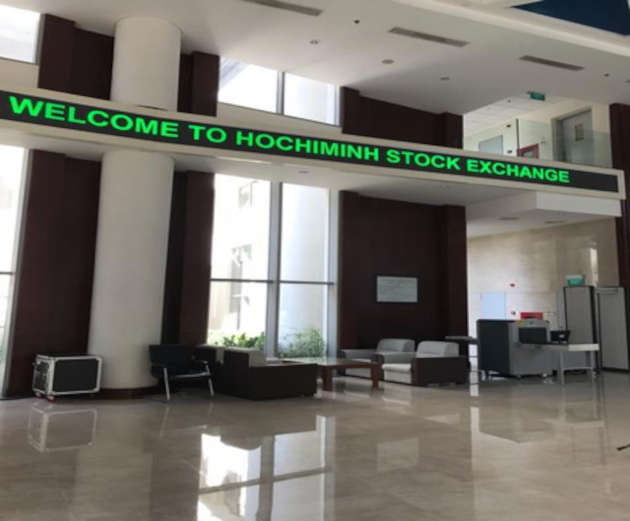Finally, the day was here: EMBA and GLEMBA 2017 cohorts visited the Ho Chi Minh Stock Exchange (HOSE) early Tuesday, April 4, morning. Everyone was so eager to experience this; we were going to visit the symbol of a market economy in a country that was built on socialist principles.
The bus driver dropped us at the gate, where Ms. My Tran, the exchange’s representative, greeted us. After we got down, she walked us into a modern building, which was surprisingly very quiet. We were now standing in the same hall where two former U.S. presidents, Bill Clinton and George W. Bush, had rang the gong and paid tribute to the new symbols of capitalism.
While inside, the security guard asked us to put our stuff through the scanners. After security, we went to the conference room located on the eighth floor. The presentation was already ready on the projector. In less than 10 minutes, Ms. Tran started the meeting and walked us through the presentation she had prepared for the group. Ms. Tran also gave us an overview on Vietnamese economy. The presentation lasted for 30 minutes, followed by an intensive Q&A from the group. This was a short visit, but it provided some very valuable takeaways for the group.


We learned that HOSE and Hanoi Exchange (HNX) are the top two of three stock markets in Vietnam. HOSE is a state-owned entity that is organized in the form of a one-member limited liability company and was inaugurated in 207. It was an upgrade of the Ho Chi Minh Securities Trading Center, created in 2000.
It was interesting to know that the exchange today has no “open cry” trading floor. All the trading happens electronically at HOSE, so the dealers do not have to be present in person at the exchange.
Today about 700 companies are listed on HOSE and HNX. Moreover, while the number of companies is somewhat evenly split between the two exchanges, the market capital certainly is not. Trading capital on HOSE, typically, drifts somewhere between $50 billion and $55 billion at any given time, while HNX stays somewhere around $6 billion.
Last year the capital invested with all three exchanges was around $70 billion, which is minimal compared to other stock exchanges of the world. To put things in perspective, the market capitalization for the New York Stock Exchange was around $19 trillion last year.
It was very evident that HOSE is in its very early development stages compared to other established stock exchanges of the world. Currently the exchange does not allow cross-exchange or joint-venture listings. The exchange has only 1.6 million active investor accounts. The scale is a lot smaller than the U.S. stock exchange. We learned that it is really challenging for foreigners to trade at Ho Chi Minh Stock Exchange. To register at the stock exchange, an individual needs to be present in Ho Chi Minh City, and the process is very intensive. Because of bureaucracy, things do not move quickly, and it may take up to 30 days for a trader to register.
Evidently, Vietnam has a lot of work ahead to get HOSE up to the global standards. The neighbor, Stock Exchange of Thailand, is aiming to be at $700 billion by 2020. HOSE would need to attract many bigger names to its portfolio. Potential investors are getting interested in Vietnam because of an emerging middle class, fantastic gross domestic product and foreign-direct-investment growth and the trade agreements. Nevertheless, 80 percent to 85 percent of HOSE traders have been local. In addition, the foreign ownership of listed companies has been limited to less than 49 percent foreign ownership.
Though it was clear that the government was taking steps to gain more market capital, we think that HOSE needs to move faster on easing the laws to attract more investors that are global. It needs easier access to foreigners and need to increase transparency. In addition, it may be helpful to require the companies to have a dual listing on the HNX Exchange and to formally link with other Asian-Pacific markets to further unlock the capital flows and trading activity.
– Written by: Ramneek Bali, Ruchika Nagrath, Diana Rodriguez





